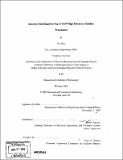| dc.contributor.advisor | Tomás Palacios. | en_US |
| dc.contributor.author | Zhao, Xu, S.M. Massachusetts Institute of Technology | en_US |
| dc.contributor.other | Massachusetts Institute of Technology. Dept. of Electrical Engineering and Computer Science. | en_US |
| dc.date.accessioned | 2008-11-07T18:57:51Z | |
| dc.date.available | 2008-11-07T18:57:51Z | |
| dc.date.copyright | 2007 | en_US |
| dc.date.issued | 2008 | en_US |
| dc.identifier.uri | http://hdl.handle.net/1721.1/43062 | |
| dc.description | Thesis (S.M.)--Massachusetts Institute of Technology, Dept. of Electrical Engineering and Computer Science, February 2008. | en_US |
| dc.description | Includes bibliographical references (leaves 66-70). | en_US |
| dc.description.abstract | In the last few years, AlGaN/GaN high electron mobility transistors (HEMTs) have become the top choice for power amplification at frequencies up to 20 GHz. Great interest currently exists in industry and academia to increase the frequency to mm-wave frequencies. The goal of this thesis has been to identify new solutions to some of the main challenges to increase this frequency performance even further. Electron velocity is a critical parameter affecting the transistor performance. In standard GaN transistors, the extremely high electric fields present in the channel of the device reduce the average electron velocity well below the peak electron velocity, resulting in low cutoff frequencies. In this thesis, we introduced a partial recess in the drain access region of the transistor to engineer the electric field along the channel of the device without introducing parasitic capacitances. By reducing the peak electric field, the average electron velocity is increased by 50%. This new technology has the potential to improve not only the cutoff frequencies, but also the breakdown voltage of GaN transistors. To successfully engineer the electric field in GaN devices, an accurate, reliable and low damage etching technology is needed. However none of the traditional GaN dry etching technologies meets these requirements. This lack of suitable technology has motivated us to develop a new atomic layer etching technique of AlGaN/GaN structures. This technology has been shown to be a self limited process with very high reliability and low damage, which will be very useful both in electric field engineering and gate recess. Finally, another factor hindering GaN HEMTs from competing with InGaAs devices at high frequencies are their high parasitic capacitances and resistances. In this thesis, ohmic drain contacts are replaced with Schottky drain contacts to reduce the drain access resistance. | en_US |
| dc.description.abstract | (cont) ADS simulations predict a very significant increase in the cutoff frequencies by virtue of the lowered parasitic resistances. In conclusion, the theoretical and experimental work developed during this project has demonstrated the great potential of three new technologies to overcome the main challenges of mm-wave GaN HEMTs. The application of these technologies to actual devices is under way and it will represent an important element of the ultra-high GaN transistors of the future. | en_US |
| dc.description.statementofresponsibility | by Xu Zhao. | en_US |
| dc.format.extent | 70 leaves | en_US |
| dc.language.iso | eng | en_US |
| dc.publisher | Massachusetts Institute of Technology | en_US |
| dc.rights | M.I.T. theses are protected by
copyright. They may be viewed from this source for any purpose, but
reproduction or distribution in any format is prohibited without written
permission. See provided URL for inquiries about permission. | en_US |
| dc.rights.uri | http://dspace.mit.edu/handle/1721.1/7582 | en_US |
| dc.subject | Electrical Engineering and Computer Science. | en_US |
| dc.title | Electric field engineering in GaN high electron mobility transistors | en_US |
| dc.type | Thesis | en_US |
| dc.description.degree | S.M. | en_US |
| dc.contributor.department | Massachusetts Institute of Technology. Department of Electrical Engineering and Computer Science | |
| dc.identifier.oclc | 244103591 | en_US |
